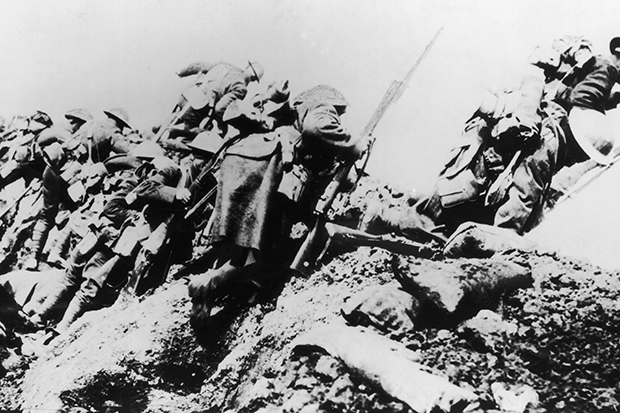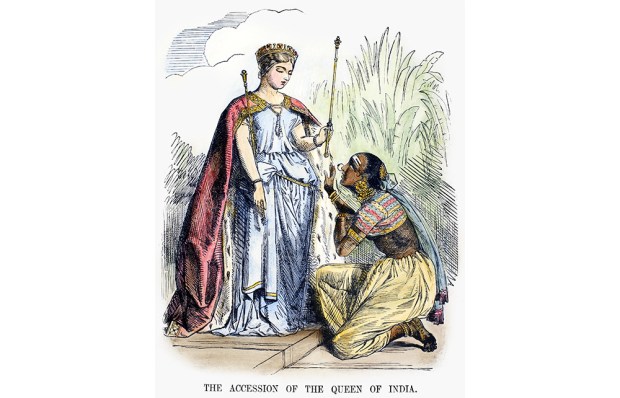‘July 1st 1916 was the most interesting day of my life,’ Philip Howe recalled, with characteristic English dryness, half a century after taking part in the most catastrophic 24 hours in the history of the British army. Howe had been a lieutenant in the 10th West Yorkshires, which had the grim distinction of losing more men during the first day on the Somme than any other battalion: of the 1,050 that went into battle, 710 became casualties, 60 per cent of whom were killed. At the end of the day Howe was the only officer left standing, and many other battalions had suffered almost as badly. The 1st Newfoundlanders lost 684 men, including all 26 of their officers, and the 11th East Lancashires, known as the Accrington Pals, suffered over 80 per cent casualties within minutes of the attack being launched: it was said that it had taken a mere ten days to raise the battalion and a mere ten minutes to annihilate it. In all some 120,000 men went over the top on that fine summer’s day in France, of whom 19,240 were killed, and another 38,231 were wounded, reported missing or taken prisoner. ‘On a 16-mile front of attack varying fortune must be expected!’ wrote Sir Douglas Haig, whose battle-plan had resulted in this calamity.
The reasons for everything going so terribly wrong have become familiar. The Allies had failed to keep the date and details of their ‘surprise’ attack secret, with the result that the Germans were well prepared for ‘the heaviest bombardment in the history of warfare’ that would immediately precede it. Although ferocious, this assault by the artillery failed to destroy the German front line, not least because a high proportion of the shells turned out to be duds. The German troops, whose numbers had been hopelessly underestimated, sat it out in their very deep and well-fortified dugouts, then emerged as soon as the bombardment was over to set up their machine guns. The British troops, each man weighed down by a wholly unnecessary 66 pounds of equipment, staggered out of their trenches and, as instructed, began walking (rather than running) in long lines (rather than safer formations) towards the German front line. Advancing into such firepower took unimaginable discipline and courage: the Newfoundlanders ‘instinctively tucked their chins into an advanced shoulder as they had done so often when fighting their way home in a blizzard’. The soldiers presented such easy targets that it took just one gunner to wipe out the Accrington Pals.
The Somme lives on in the collective memory, symbolising for many people the tragedy and wastefulness of the first world war. As its centenary approaches, there will no doubt be many other books on the subject, and one assumes Andrew Roberts is publishing his account this year rather than next in order to get in ahead of everyone else. The classic account of this disaster remains Martin Middlebrook’s The First Day on the Somme, published in 1971. Middlebrook was not a professional historian, but a Lincolnshire farmer who had been prompted to write his book after seeing the war cemeteries of the Western Front. Elegy is constructed like Middlebrook’s book, with chapters on strategy, tactics and preparation leading up to the pivotal ‘Zero Hour’, though Roberts extends his narrative to provide an analysis of the lessons learned from the battle and the Somme’s significance in the chronology of the war.
Although Middlebrook drew on official histories and contemporary newspapers, memoirs and other literary representations, what made his book both pioneering and hauntingly eloquent was his use of the oral testimony of those like Philip Howe who had taken part in the battle. The list of veterans who contributed to his book runs to more than ten closely printed pages, but these men are no longer here to bear witness. The last surviving person to have gone into action on 1 July 1916, Pte Charles Holman of the 1st Essex Regiment, died in January 2002 at the age of 103. Deprived of this source, Roberts instead makes occasional and effective use of written testimony kept at the Imperial War Museum, but his book is largely a synthesis of secondary sources. Although there is nothing wrong with this in principle, particularly when it is done with Roberts’s skill, it sometimes leads him astray. For example, he quotes a farewell letter that he says Lt Malcolm White ‘wrote to his family’ in the early hours of the morning of the attack, giving the source as Richard Van Emden’s Tommy’s War (2014). Readers may be puzzled by White addressing his family as ‘Man’, but had Roberts gone to what was presumably Van Emden’s source, a memoir and collection of White’s letters published in 1919, he would realise that his quotation in fact runs two letters together, one indeed written to his family, but the other written to a friend — hence the ‘Man’. He would also have seen that the letters were written not on the morning of the attack but two days before it, and he would not have described White, who was eight months short of his 30th birthday, as being ‘in his mid-twenties’.
Roberts also writes several times of the part played on the Somme by ‘the future poet laureate, Cecil Day-Lewis’, who would have been 12 years old at the time. Once again, had Roberts gone to the original source, the celebrated pilot Cecil Lewis’s Sagittarius Rising (1936) — which is after all one of the great classics of the war and still in print — rather than merely relying upon quotations from it in Robert Cowley’s The Great War (2004), he would not have committed this embarrassing howler, which an editor should certainly have picked up.
The book also contains some surprising errors. Some of these, such as misspelling the nickname of the captain who famously led his men into action kicking a football, or getting wrong the rank of the luckless Canadian soldier shot dead two minutes before the Armistice, are relatively trivial. It does, however, seem astonishing that Roberts appears to believe that those British soldiers executed for desertion and cowardice during the war have not been granted a posthumous pardon: they were, back in 2006, and now have their own striking ‘Shot at Dawn’ memorial in the National Memorial Arboretum in Staffordshire.
Elegy does, however, have compensating virtues. It is always highly readable, gives a succinct and cohesive overview of the day, and is hearteningly even-handed. While not entirely exonerating Haig, for example, Roberts points out that many of the general’s much-criticised decisions were the result of bad advice and poor intelligence. Nor does he lose sight of the men on the ground who were directly affected by these decisions, as many military historians do: like Churchill’s in The World Crisis 1911–1918, his account ends with a paean to the heroism of those ordinary men who died in their thousands. These deaths, he argues, ‘forced the British army to learn how to win the first world war’, and lessons learned from the battle undoubtedly contributed to the spectacular military successes of 1918. That said, anyone who has been to the battlefield, which is now a patchwork of war cemeteries dominated by Lutyens’s vast Monument to the Missing of the Somme, might question his conclusion that ‘The sacrifice of 1 July 1916 had at last been justified’.
Got something to add? Join the discussion and comment below.
Get 10 issues for just $10
Subscribe to The Spectator Australia today for the next 10 magazine issues, plus full online access, for just $10.
Available from the Spectator Bookshop, £18 Tel: 08430 600033
You might disagree with half of it, but you’ll enjoy reading all of it. Try your first month for free, then just $2 a week for the remainder of your first year.














Comments
Don't miss out
Join the conversation with other Spectator Australia readers. Subscribe to leave a comment.
SUBSCRIBEAlready a subscriber? Log in